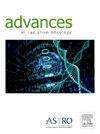Cell-Free Circulating Tumor DNA for NonInvasive Molecular Profiling Among Patients Undergoing Definitive Chemoradiation for Locally Advanced Lung Cancer
IF 2.2
Q3 ONCOLOGY
引用次数: 0
Abstract
Purpose
We prospectively explored the utility of liquid biopsy for cell-free circulating tumor DNA (ctDNA) as a prognostic and predictive biomarker in patients with non-small cell lung cancer (NSCLC) treated with definitive chemoradiation therapy.
Methods and Materials
This prospective clinical cohort consisted of patients with unresectable, locally advanced NSCLC who had liquid biopsy testing before initiation of cancer therapy. Liquid biopsy testing was performed using an institutional assay that included 129 genes and paired white blood cell sequencing. Variant allele frequency was defined as the proportion of mutant alleles at a particular genetic locus. A US Food and Drug Administration-recognized database (OncoKB) was used to classify alterations. We evaluated progression-free survival from the start of radiation therapy using the log-rank test.
Results
Among 25 patients with prospective testing of ctDNA levels before therapy initiation, 18 patients had adenocarcinoma (72%), 7 patients had squamous cell carcinoma (28%), and 23 (92%) were former or current smokers. Twelve patients (48%) received adjuvant durvalumab. The median radiation dose was 60 Gy in 30 fractions (range, 55-66 Gy in 20-33 fractions). Seventy-six percent of patients (n = 18) had one or more alterations detected (median, 3 alterations, range, 1-8), including genomic markers of radiation response in 3 patients. The most common driver alteration detected was KRAS mutation in 24% of the cohort (n = 6). The detection of ctDNA levels was significantly associated with pretreatment 18F-fluorodeoxyglucose positron emission tomography standardized uptake value metrics, and the association was strengthened by integrating the number of mutations (compared with variant allele frequency) as the outcome variable. Among patients with baseline detectable ctDNA levels, the median progression-free survival was 21.3 months and was not reached among patients without baseline ctDNA level detection (hazard ratio, 4.54, P = .04).
Conclusions
Prospective liquid biopsy testing among patients treated with definitive chemoradiation therapy identifies driver alterations and markers of radiation response with direct implications for therapy personalization.
局部晚期肺癌晚期放化疗患者无细胞循环肿瘤DNA无创分子谱分析
目的前瞻性探讨液体活检检测游离循环肿瘤DNA (ctDNA)作为非小细胞肺癌(NSCLC)终期放化疗患者预后和预测性生物标志物的应用价值。方法和材料该前瞻性临床队列包括不可切除的局部晚期非小细胞肺癌患者,他们在癌症治疗开始前进行了液体活检检查。液体活检检测采用机构分析,包括129个基因和配对白细胞测序。变异等位基因频率定义为突变等位基因在特定遗传位点的比例。使用美国食品和药物管理局认可的数据库(OncoKB)对变化进行分类。我们使用log-rank检验评估放射治疗开始时的无进展生存期。结果在25例治疗前进行ctDNA水平前瞻性检测的患者中,18例患有腺癌(72%),7例患有鳞状细胞癌(28%),23例(92%)曾经或现在是吸烟者。12名患者(48%)接受了durvalumab辅助治疗。中位辐射剂量为60 Gy,分为30组(范围为55 ~ 66 Gy, 20 ~ 33组)。76%的患者(n = 18)检测到一个或多个改变(中位数,3个改变,范围,1-8),包括3例患者的放射反应基因组标记。在24%的队列中,检测到的最常见的驱动改变是KRAS突变(n = 6)。ctDNA水平的检测与预处理18f -氟脱氧葡萄糖正电子发射断层扫描标准化摄取值指标显著相关,并且通过将突变数量(与变异等位基因频率相比)作为结果变量,这种关联得到了加强。在基线检测到ctDNA水平的患者中,中位无进展生存期为21.3个月,而在未检测到基线ctDNA水平的患者中,中位无进展生存期未达到(风险比为4.54,P = 0.04)。结论:在接受明确放化疗的患者中,前瞻性液体活检检测可识别放射反应的驱动改变和标志物,对治疗个性化具有直接意义。
本文章由计算机程序翻译,如有差异,请以英文原文为准。
求助全文
约1分钟内获得全文
求助全文
来源期刊

Advances in Radiation Oncology
Medicine-Radiology, Nuclear Medicine and Imaging
CiteScore
4.60
自引率
4.30%
发文量
208
审稿时长
98 days
期刊介绍:
The purpose of Advances is to provide information for clinicians who use radiation therapy by publishing: Clinical trial reports and reanalyses. Basic science original reports. Manuscripts examining health services research, comparative and cost effectiveness research, and systematic reviews. Case reports documenting unusual problems and solutions. High quality multi and single institutional series, as well as other novel retrospective hypothesis generating series. Timely critical reviews on important topics in radiation oncology, such as side effects. Articles reporting the natural history of disease and patterns of failure, particularly as they relate to treatment volume delineation. Articles on safety and quality in radiation therapy. Essays on clinical experience. Articles on practice transformation in radiation oncology, in particular: Aspects of health policy that may impact the future practice of radiation oncology. How information technology, such as data analytics and systems innovations, will change radiation oncology practice. Articles on imaging as they relate to radiation therapy treatment.
 求助内容:
求助内容: 应助结果提醒方式:
应助结果提醒方式:


